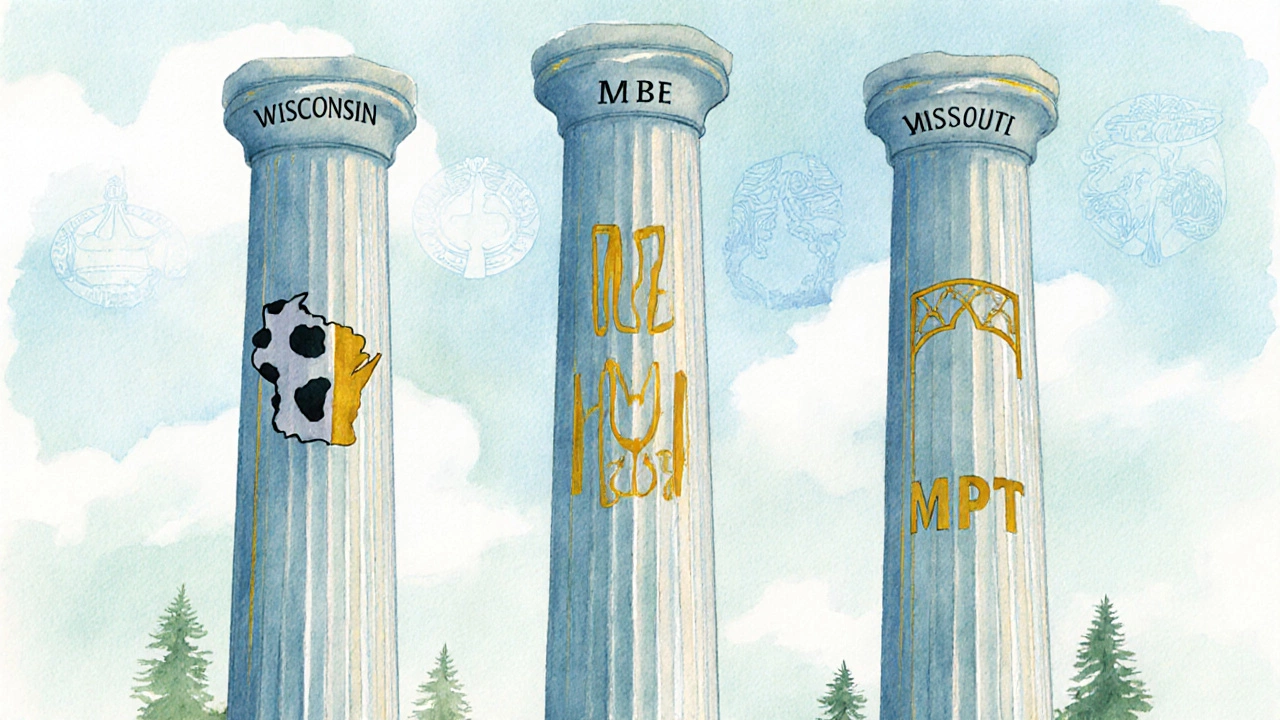Key Takeaways
- The Uniform Bar Exam (UBE) creates a common baseline, but pass rates still vary by state.
- Historically, Wisconsin, Missouri and Idaho have posted the highest pass percentages, making them the "easiest" in practice.
- Pass rate alone doesn’t tell the whole story - grading schemes, test‑day policies and jurisdictional experience curves matter.
- Focus on strong Multistate Bar Examination (MBE) preparation and understand each state’s "written" component to boost your odds.
- Tailor your study plan to the state you’ll sit in, but reuse core strategies for any bar exam.
When aspiring lawyers talk about the Bar Exam is a comprehensive, multi‑day test that determines whether a candidate is qualified to practice law in a given US jurisdiction, they’re referring to a state‑specific licensing hurdle. Some candidates wonder if picking a particular state can make the journey smoother. In plain terms, the answer hinges on two things: the uniform framework most states use and the actual pass‑rate numbers each state reports.
Understanding the Bar Exam Landscape
Every US state runs its own bar exam, but most have adopted the Uniform Bar Exam (UBE) model. The UBE bundles three core components: the Multistate Bar Examination (MBE), the Multistate Essay Examination (MEE) and the Multistate Performance Test (MPT). The MBE is a 200‑question multiple‑choice test that covers contracts, torts, constitutional law, criminal law, civil procedure, evidence, and real property. Because the MBE is the same everywhere, the raw knowledge needed to ace it doesn’t change from California to Texas.
The state‑specific part comes in the form of additional essay questions, local law sections, and differing grading policies. Some states, like California, add a separate state‑law portion that can be a pain point for out‑of‑state students. Others, like Wisconsin, stick almost entirely to the UBE components, meaning the exam feels “easier” for those already comfortable with the MBE format.
How the Uniform Bar Exam Levels the Playing Field
Since 2010, the Uniform Bar Exam (UBE) has become the national benchmark. The advantage is clear: you can take the UBE in one state, transfer the score to another, and avoid relearning the core content. However, each jurisdiction sets its own passing score, typically ranging from 260 to 280 on a 400‑point scale. That sliding scale explains why a 275 could be a pass in New York but a fail in Illinois.
Because the UBE is uniform, the “easiest” exam isn’t about a softer syllabus-it’s about the pass‑rate threshold and how strictly the state grades the written portions. States that keep the passing score at the lower end of the range, or that give generous credit for the MBE, often record the highest success percentages.

Pass Rates as a Proxy for Difficulty
Bar‑exam pass rates are the single most‑cited metric when ranking difficulty. The National Conference of Bar Examiners (NCBE) releases official numbers every February. Looking at the 2023‑2024 cohort, a few states consistently outpace the national average of 68%:
| State | Pass Rate % | Notes |
|---|---|---|
| Wisconsin | 92 | Pure UBE, low passing score |
| Missouri | 88 | UBE‑only, generous grading |
| Idaho | 86 | UBE, small candidate pool |
| Colorado | 80 | UBE with light state‑law focus |
| North Dakota | 79 | UBE, historic high pass rate |
These five states dominate the “easiest” conversation because their pass percentages sit well above the national mean. Notice that all are UBE‑adopters, reinforcing the idea that a unified exam reduces variability.
States Often Cited as the Easiest
Beyond raw numbers, law‑school forums and bar‑prep providers point to three states that feel less intimidating:
- Wisconsin Bar Exam - The state runs a straight‑UBE format, no extra state‑law essays, and a passing score of 260, the lowest among UBE states.
- Missouri Bar Exam - Uses the UBE exclusively and applies a “scaled‑score” system that often skews higher for well‑prepared candidates.
- Idaho Bar Exam - Small test‑taker pool, UBE‑only, and a passing score of 270, slightly lower than the national average.
When you hear the phrase easiest bar exam in a conversation, it’s usually these jurisdictions that come up. They combine a low hurdle score, a short written component, and a heavy reliance on the MBE - which many candidates find the most predictable part.
Why Pass Rate Isn’t Everything
Treating pass rate as the sole indicator can mislead you. A state might report a 95% pass rate simply because it only allows graduates from its own law schools to sit for the test, dramatically shrinking the pool. Conversely, New York’s 71% rate looks modest, but the state admits thousands of out‑of‑state candidates, raising the difficulty bar.
Other hidden factors matter:
- Grading leniency: Some jurisdictions award partial credit on essays more generously.
- Retake policies: States allowing multiple attempts in the same year can boost overall pass percentages.
- Exam timing: Summer sittings often see higher pass rates because candidates have fresh summer courses behind them.
So, while Wisconsin, Missouri and Idaho rank high, you should still weigh personal fit, career goals, and where you plan to practice.
Tips for Preparing No Matter the State
Regardless of the jurisdiction, the following study habits increase your odds:
- Master the MBE first. Use commercial question banks (e.g., Adaptibar, BARBRI) to lock down the multiple‑choice format.
- Schedule your essay practice around the state’s specific topics. For UBE‑only states, focus on the MEE prompts that appear in the national pool.
- Take at least two full‑length practice exams under timed conditions. Simulating test‑day stamina is crucial.
- Review every wrong answer. Understanding why an option is incorrect cements the underlying principle.
- Join a study group or online forum. Explaining concepts to peers reveals gaps you didn’t notice.
When you pair these habits with knowledge of your chosen state’s grading quirks, you create a winning formula regardless of whether the exam is technically the “easiest.”
Common Pitfalls to Avoid
Even the simplest‑looking bar exams trip up candidates. Here are three traps to watch out for:
- Ignoring state‑law essays: In non‑UBE states (California, New York), the local law portion can sink an otherwise solid MBE score.
- Under‑estimating the performance test (MPT): It tests practical lawyering skills, not theory. Treat it like a real client memorandum.
- Last‑minute cramming: The bar measures endurance as much as knowledge. Consistent, spaced repetition beats a weekend marathon.
By sidestepping these errors, you protect your hard work and give yourself the best shot at passing.
Bottom Line
If your only goal is to sit for the state with the highest historical pass rates, Wisconsin, Missouri and Idaho are the clear front‑runners. Their reliance on the UBE, low passing scores, and generous grading make them the practical answer to the question “What state has the easiest bar exam?” Yet, the smartest strategy blends this data with personal career plans and solid preparation habits.
Which state has the highest bar exam pass rate?
In the 2024 reporting cycle, Wisconsin topped the list with a 92% pass rate, followed by Missouri (88%) and Idaho (86%).
Does a higher pass rate mean the exam is easier?
Not always. A high pass rate can reflect a low passing score, a small candidate pool, or generous grading. Consider both the pass rate and the state’s exam format.
What is the Uniform Bar Exam (UBE)?
The UBE combines the Multistate Bar Examination (MBE), the Multistate Essay Examination (MEE) and the Multistate Performance Test (MPT) into a single, portable score used by most adopting states.
Can I transfer my UBE score to another state?
Yes, as long as the destination state accepts UBE scores and you meet any additional local requirements, such as a state‑law essay.
How should I study if I aim for an "easy" state?
Treat the exam like any other bar: master the MBE, practice essays, take full‑length mocks, and learn the specific grading nuances of your chosen jurisdiction.
